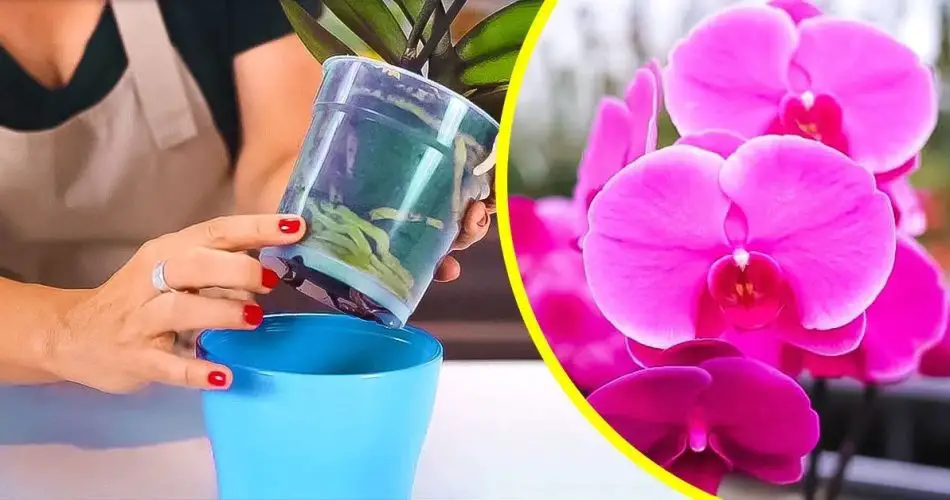There is a real paradox when it comes to orchids: they are often seen as fragile plants, yet they can thrive and bloom even in the hands of inexperienced gardeners. Here’s everything you need to know for the proper maintenance of indoor orchids, specifically the Phalaenopsis variety.

Understanding Phalaenopsis
Phalaenopsis, a member of the Orchidaceae family, is native to tropical regions of Asia, including the Philippines and Indonesia. Discovered by Dutch botanist Blume in 1825, this orchid gets its name from the Greek words meaning “butterfly,” as its flowers resemble these insects. With approximately 48 species and thousands of hybrids, Phalaenopsis orchids are primarily epiphytes, thriving on the upper branches of trees, shielded from direct sunlight.
Orchid Anatomy
- Each flower features five petals and a central “lip” that acts as a landing strip for pollinators.
- The leaves are fleshy and oval, measuring between 10 to 40 cm long and varying in color from light to dark green.
- Inflorescences typically emerge from the axil of the lower leaf and can range from a few centimeters to 1 meter in length.
Growing Conditions

Phalaenopsis orchids naturally grow in the Asian and Australian rainforest.
- Temperature: Ideal range is between 18°C and 25°C during the growing season, with a nighttime minimum of 16°C. Young plants may need slightly warmer conditions.
- Humidity: They tolerate higher temperatures if humidity levels are good.
Fertilizing Orchids
- Begin adding very light doses of fertilizer in early spring (March/April). Avoid fertilizing in winter, as orchids are dormant during this time.
- Avoid fertilizer sticks, as they can harm roots by releasing concentrated nutrients directly.

Watering Your Orchid
- Watering Frequency: Water regularly but not excessively to prevent root rot. In spring and summer, water twice a week, while in winter, reduce this to twice a month.
- Method: Water the base of the plant using room temperature water, avoiding hard water. Never allow the plant to sit in water except for occasional soaking.
The Right Location
- Orchids need bright, indirect light and should be kept away from cold drafts and ethylene-producing fruits (like bananas and tomatoes).
- Some varieties, like Cymbidium, can be placed outside in summer, while Phalaenopsis should remain indoors.

Repotting Your Orchid
- Repotting can occur year-round, but it’s best done in spring or late summer.
- Avoid repotting during flowering.
Repotting Technique:
- Carefully remove the orchid from its pot.
- Eliminate dead roots and shorten aerial roots longer than 20 cm.
- Fill half of the new pot with substrate, center the plant, and fill the rest, tamping lightly.
- Maintain humidity and warmth post-repotting but avoid direct sunlight.
Handling Keikis
Keikis are baby orchids that develop from the parent plant. They should be collected when their roots are around 4-5 cm long and repotted in a finer substrate. This process encourages rapid growth and early blooming.
Natural Pest Control
To combat mealybugs naturally, mix:
- 1 teaspoon of black soap or liquid hand soap
- 1 teaspoon of rubbing alcohol
- 1 teaspoon of vegetable oil in 1 liter of water. Spray on leaves and rub gently.
Precautions When Buying Orchids
After purchasing a Phalaenopsis, keep it isolated for about 15 days to ensure it’s disease-free. Check for healthy roots and leaves before buying, and avoid orchids from the produce section.
Colors and Scents of Orchids
Orchids come in many colors—white, yellow, pink, and purple—but there is no blue Phalaenopsis; that is simply ink. Various species also offer delightful fragrances, such as Phalaenopsis cochlearis, which emits a scent reminiscent of honeysuckle.
Common Orchid Diseases
- Excess Moisture: Soft leaves and damaged roots indicate overwatering.
- Rhizome Rot: Caused by fungi and bacteria due to poor cultivation practices.
- Falling Buds: Often due to lack of light or cold conditions.
- Sunburn: Move the plant out of direct sunlight.
- Bacterial Attack: Cut off affected parts and improve ventilation.
- Pests: Address mealybugs and scale insects promptly.
- Water Issues: Provide a bath for dehydrated plants.
Symptoms of Stress
- Insufficient growth or yellowing leaves
- Spots on leaves transitioning from yellow to brown
- Flabby or falling flower buds
Solutions to Common Problems
- Repot the orchid and clean unhealthy roots.
- Place in a well-lit but shaded area.
- Maintain humidity and avoid direct sunlight.
With these steps, you can successfully care for your orchids and encourage them to bloom beautifully once again!



